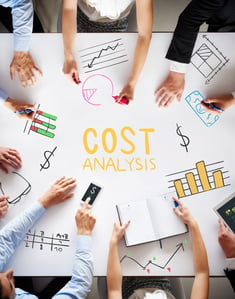The Ultimate Guide to Procurement Cost Savings: Tips, Tricks, and Best Practices

Introduction to Procurement Cost Savings
Procurement cost savings refer to the reduction of expenses associated with the procurement process. It involves finding ways to minimize costs without compromising the quality of goods or services purchased. This is a critical aspect of business operations as it directly impacts the bottom line and profitability.
For businesses, procurement cost savings are of utmost importance. By reducing costs, companies can increase their profit margins and improve their financial performance. This is especially crucial in today’s competitive business environment where companies are constantly looking for ways to stay ahead of the competition. By implementing effective cost-saving strategies in procurement, businesses can gain a competitive advantage and ensure long-term success.

Understanding the Procurement Process
The procurement process involves a series of steps that businesses undertake to acquire goods or services from external suppliers. It typically includes identifying the need for a product or service, sourcing potential suppliers, negotiating contracts, and managing supplier relationships. Effective procurement management is essential for businesses to ensure that they are getting the best value for their money.
Key players in the procurement process include the procurement team, which is responsible for managing the entire process, as well as stakeholders such as department heads and budget holders who have specific requirements and budgets. Effective collaboration and communication among these key players are crucial for successful procurement.
Identifying Cost Saving Opportunities
To identify cost-saving opportunities in procurement, businesses need to conduct a thorough spend analysis. This involves analyzing historical spending data to identify areas where costs can be reduced. By understanding spending patterns and trends, businesses can identify areas where they are overspending or where there is potential for negotiation with suppliers.
Once cost-saving opportunities have been identified, it is important to prioritize them based on their potential impact on the bottom line. Businesses should focus on areas where significant savings can be achieved without compromising quality or service levels. This requires careful analysis and consideration of various factors such as supplier relationships, market conditions, and business priorities.
Negotiation Strategies for Procurement
Negotiation plays a crucial role in procurement cost savings. By effectively negotiating with suppliers, businesses can secure better pricing, terms, and conditions, resulting in significant cost savings. It is important to approach negotiations strategically and be prepared with relevant information and data.
Key negotiation strategies for cost savings include conducting thorough research on market prices, understanding supplier costs and margins, and leveraging competition among suppliers. Businesses should also be willing to walk away from a deal if it does not meet their cost-saving objectives. By being assertive and confident in negotiations, businesses can achieve favorable outcomes and maximize cost savings.
Supplier Relationship Management
Supplier relationship management is a critical aspect of procurement cost savings. By building strong relationships with suppliers, businesses can negotiate better deals, gain access to exclusive discounts or incentives, and improve overall supplier performance. Effective supplier relationship management involves regular communication, collaboration, and mutual trust.
Strategies for building strong supplier relationships include setting clear expectations, providing feedback and performance evaluations, and fostering open and transparent communication. It is also important to establish long-term partnerships with key suppliers to ensure stability and consistency in the supply chain.
Leveraging supplier relationships for cost savings involves exploring opportunities for collaboration and innovation. By working closely with suppliers, businesses can identify areas where costs can be reduced through joint process improvements or value engineering.
Implementing Cost Saving Measures
Implementing cost-saving measures requires careful planning and execution. Businesses should develop a detailed implementation plan that outlines specific actions, timelines, and responsibilities. It is important to involve key stakeholders and obtain their buy-in to ensure successful implementation.
Stakeholder buy-in is crucial as it helps overcome resistance to change and ensures that everyone is aligned with the cost-saving objectives. Businesses should communicate the benefits of the cost-saving measures and address any concerns or objections raised by stakeholders. By involving stakeholders in the implementation process, businesses can increase the likelihood of success and sustain cost savings in the long run.
Tips for successful implementation include monitoring and tracking progress, conducting regular reviews and evaluations, and making adjustments as needed. It is also important to celebrate successes and recognize the efforts of individuals or teams involved in the implementation process.
Leveraging Technology for Procurement Cost Savings
Technology plays a crucial role in procurement cost savings. There are various procurement technology solutions available that can streamline and automate the procurement process, improve efficiency, and reduce costs. These solutions typically include e-procurement platforms, spend analytics tools, contract management systems, and supplier relationship management software.
Benefits of technology for procurement cost savings include improved visibility into spending patterns, enhanced data analysis capabilities, streamlined supplier management, and increased process efficiency. By leveraging technology, businesses can identify cost-saving opportunities more effectively, negotiate better deals, and track and report cost savings more accurately.
Key features to look for in procurement technology include user-friendly interfaces, integration capabilities with existing systems, robust reporting and analytics functionalities, and scalability to accommodate future growth. It is important to carefully evaluate different technology solutions and choose the one that best meets the specific needs and requirements of the business.
Best Practices for Procurement Cost Savings
There are several best practices that businesses can adopt to maximize procurement cost savings. These include:
1. Conducting regular spend analysis: Businesses should regularly analyze their spending patterns to identify areas where costs can be reduced. This involves reviewing historical spending data, identifying trends and patterns, and benchmarking against industry standards.
2. Developing strategic sourcing strategies: Businesses should develop strategic sourcing strategies that focus on achieving the best value for money. This involves identifying potential suppliers, conducting thorough evaluations, and negotiating favorable contracts.
3. Implementing effective contract management: Effective contract management is crucial for ensuring that suppliers adhere to agreed-upon terms and conditions. Businesses should establish clear contract management processes and systems to monitor supplier performance and compliance.
4. Encouraging collaboration and innovation: Businesses should foster a culture of collaboration and innovation with suppliers. By working closely with suppliers, businesses can identify opportunities for joint cost-saving initiatives and process improvements.
5. Continuous improvement: Continuous improvement is key to sustaining cost savings in the long run. Businesses should regularly review and evaluate their procurement processes, identify areas for improvement, and implement necessary changes.
Measuring and Tracking Procurement Cost Savings
Measuring and tracking cost savings is essential to assess the effectiveness of procurement cost-saving initiatives and demonstrate their impact on the bottom line. Key metrics for measuring procurement cost savings include:
1. Cost savings as a percentage of total spend: This metric measures the percentage of cost savings achieved relative to the total spend. It provides an overall view of the effectiveness of cost-saving initiatives.
2. Cost savings per category or supplier: This metric measures the cost savings achieved for specific categories or suppliers. It helps identify areas where cost savings are most significant and where further improvements can be made.
3. Return on investment (ROI): ROI measures the financial return generated from cost-saving initiatives relative to the investment made. It helps assess the profitability and efficiency of procurement cost-saving efforts.
To effectively measure and track cost savings, businesses should establish clear tracking and reporting processes. This involves setting up systems to capture relevant data, analyzing the data to calculate cost savings, and generating regular reports to communicate the results to key stakeholders.
Tips for effective tracking and reporting include using standardized templates or formats, ensuring data accuracy and consistency, and providing clear explanations of the methodology used to calculate cost savings. It is also important to communicate the results in a clear and concise manner, highlighting the key findings and implications for the business.
Overcoming Common Procurement Cost Saving Challenges
There are several common challenges that businesses may face when implementing procurement cost-saving initiatives. These include:
1. Resistance to change: Implementing cost-saving measures often requires changes to existing processes and systems. Resistance to change from employees or stakeholders can hinder the implementation process. To overcome this challenge, businesses should communicate the benefits of the cost-saving initiatives, address concerns or objections, and involve key stakeholders in the decision-making process.
2. Lack of data or information: Effective cost-saving initiatives require accurate and reliable data. However, businesses may face challenges in accessing or analyzing the necessary data. To overcome this challenge, businesses should invest in data management systems and processes, conduct regular data audits, and establish data governance frameworks.
3. Limited supplier options: Businesses may face challenges in finding alternative suppliers or negotiating better deals due to limited options in the market. To overcome this challenge, businesses should invest in supplier relationship management, conduct thorough market research, and explore opportunities for collaboration or partnerships with suppliers.
4. Lack of stakeholder buy-in: Lack of buy-in from key stakeholders can hinder the implementation of cost-saving initiatives. To overcome this challenge, businesses should involve stakeholders in the decision-making process, communicate the benefits of the cost-saving initiatives, and address any concerns or objections raised.
5. Inadequate resources or expertise: Implementing cost-saving initiatives may require additional resources or expertise that businesses may not have internally. To overcome this challenge, businesses can consider outsourcing certain procurement activities or investing in training and development programs for their procurement teams.
Conclusion: The Importance of Procurement Cost Savings for Business Success
In conclusion, procurement cost savings are crucial for business success. By reducing costs in the procurement process, businesses can increase their profit margins, improve their financial performance, and gain a competitive advantage. Effective procurement cost-saving strategies involve conducting spend analysis, identifying cost-saving opportunities, negotiating with suppliers, building strong supplier relationships, implementing cost-saving measures, leveraging technology, adopting best practices, measuring and tracking cost savings, and overcoming common challenges.
Businesses should prioritize procurement cost savings and invest in the necessary resources, systems, and processes to achieve sustainable cost reductions. By continuously improving their procurement practices and focusing on procurement Cost Savings initiatives, businesses can ensure long-term success and profitability.

